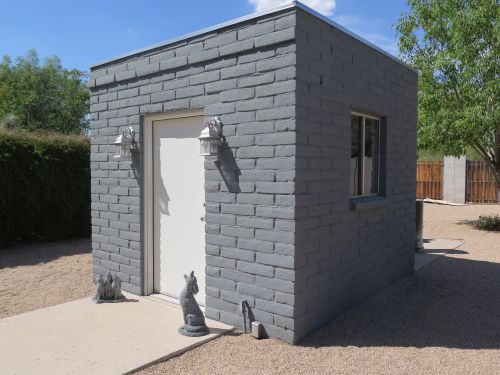
We’re long past the End of Owgust. The End of September is upon us, and my pool is still at 93° F. Why? It has nothing to do with global warming, and everything to do with a 20′ by 40′ sheet of blue bubble wrap. Back toward the end of spring, Carol and I bought a swimming pool cover. It came in a box, and it was just what I described: a 20′ X 40′ sheet of bubble wrap. I had to modify the corners a little to make it fit my idiosyncratically shaped in-ground pool, but that took less than an hour with a pair of ordinary scissors.
Now, in a riproaring Phoenix summer, you don’t need no steenking pool cover to keep your pool upwards of 90°. Just sitting there in the sun all day, my 44,000 gallon diving pool hit 95 degrees in early July all by its lonesome. But as we got into September and the days got shorter, the water temp soon fell to 85°. This feels great when the air temp is 110, but the air temp fell with the length of the day, and especially in our late-evening dips before bed, the air temp was in the high 80s and the water actually felt better warm. So two weeks ago, with the water temp at 85°, we dragged out the pool cover and wrestled it into place on the water.
Then, day by day, we boggled as the water temperature rose. By this afternoon, with a daily high a mere 100° (lukewarm by Phoenix standards) the water was at 93°. Carol’s sister Kathy is coming down for a visit in ten days, and she’s expecting warm days and warm pool water. The days will be in the 90s, which, if your’re accustomed to Chicago weather, is plenty warm. The challenge is to keep the water above 90° into the middle of October. I was a little worried about that.
Not anymore.
It’s been an interesting science experiment. At the end of a sunny day, the water immediately under the pool cover comes very close to 100°. That’s just for the top 2″ or so. When the pool pump kicks in at 8PM, it mixes that hot top layer with the cooler water beneath it. Come morning, the water is all mixed, and has gained half a degree or more throughout. The pool cover prevents most of the radiation by which pools lose their warmth at the end of summer. With the Sun to add new heat every day, and the cover to prevent it from radiating into the night sky, the pool accumulates heat. I think that 93° is the equilibrium temperature when the daily highs hover around 100°. We’re heading into a cooler week, so I don’t know precisley how that’s going to go, but as long as I can maintain 90° I’ll be more than happy.
The cover cost about $200. This may seem high for a sheet of bubble wrap, but in truth, it’s not the same kind of bubble wrap you get at the UPS Store to stuff in around the knicknacks you’re shipping to your godmother. The plastic is heavier and more rugged, and with some luck and careful handling could last 3-4 years.
Kathy’s visit will be a good test, but the primary experiment is to find out how long the cover can extend pool season, which by our definition is when the pool is at 82°or higher. We’re expecting to make it to Halloween, and–given reasonably warm weather and all sunny days–hoping to make it to Thanksgiving. There will be another experiment next March or April, to see when the cover brings the pool temp up to 82° for the first time in the season.
Sometime this winter, we’re going to have the pool “depth-modified,” which means that they’re going to jackhammer out the plaster, fill in the 9′ deep end, and replaster it to become a “play pool,” which will be 5′ in the center, and 3-4′ deep at both ends. I was never much of a diver, and I think we may score a discount on our homowner’s policy for getting rid of that 9′ depth. With only 30,000 gallons or so in the modified pool, who knows? We could be in the water 9 months out of the year. Maybe more.
Solar power rocks. It isn’t all photovoltaics.















